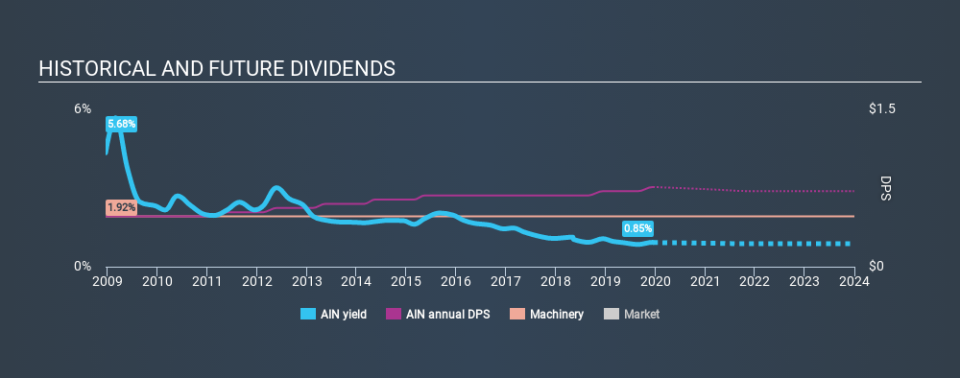Albany International Corp. (NYSE:AIN)'s Could Be A Buy For Its Upcoming Dividend

It looks like Albany International Corp. (NYSE:AIN) is about to go ex-dividend in the next 3 days. If you purchase the stock on or after the 20th of December, you won't be eligible to receive this dividend, when it is paid on the 8th of January.
Albany International's next dividend payment will be US$0.19 per share. Last year, in total, the company distributed US$0.72 to shareholders. Based on the last year's worth of payments, Albany International has a trailing yield of 0.9% on the current stock price of $82.31. We love seeing companies pay a dividend, but it's also important to be sure that laying the golden eggs isn't going to kill our golden goose! That's why we should always check whether the dividend payments appear sustainable, and if the company is growing.
Check out our latest analysis for Albany International
Dividends are usually paid out of company profits, so if a company pays out more than it earned then its dividend is usually at greater risk of being cut. Albany International paid out just 19% of its profit last year, which we think is conservatively low and leaves plenty of margin for unexpected circumstances. A useful secondary check can be to evaluate whether Albany International generated enough free cash flow to afford its dividend. What's good is that dividends were well covered by free cash flow, with the company paying out 18% of its cash flow last year.
It's encouraging to see that the dividend is covered by both profit and cash flow. This generally suggests the dividend is sustainable, as long as earnings don't drop precipitously.
Click here to see the company's payout ratio, plus analyst estimates of its future dividends.
Have Earnings And Dividends Been Growing?
Businesses with strong growth prospects usually make the best dividend payers, because it's easier to grow dividends when earnings per share are improving. If earnings decline and the company is forced to cut its dividend, investors could watch the value of their investment go up in smoke. That's why it's comforting to see Albany International's earnings have been skyrocketing, up 46% per annum for the past five years. Albany International looks like a real growth company, with earnings per share growing at a cracking pace and the company reinvesting most of its profits in the business.
Another key way to measure a company's dividend prospects is by measuring its historical rate of dividend growth. Albany International has delivered 4.7% dividend growth per year on average over the past ten years. Earnings per share have been growing much quicker than dividends, potentially because Albany International is keeping back more of its profits to grow the business.
The Bottom Line
Has Albany International got what it takes to maintain its dividend payments? We love that Albany International is growing earnings per share while simultaneously paying out a low percentage of both its earnings and cash flow. These characteristics suggest the company is reinvesting in growing its business, while the conservative payout ratio also implies a reduced risk of the dividend being cut in the future. It's a promising combination that should mark this company worthy of closer attention.
Wondering what the future holds for Albany International? See what the five analysts we track are forecasting, with this visualisation of its historical and future estimated earnings and cash flow
We wouldn't recommend just buying the first dividend stock you see, though. Here's a list of interesting dividend stocks with a greater than 2% yield and an upcoming dividend.
If you spot an error that warrants correction, please contact the editor at editorial-team@simplywallst.com. This article by Simply Wall St is general in nature. It does not constitute a recommendation to buy or sell any stock, and does not take account of your objectives, or your financial situation. Simply Wall St has no position in the stocks mentioned.
We aim to bring you long-term focused research analysis driven by fundamental data. Note that our analysis may not factor in the latest price-sensitive company announcements or qualitative material. Thank you for reading.

 Yahoo Finance
Yahoo Finance 
